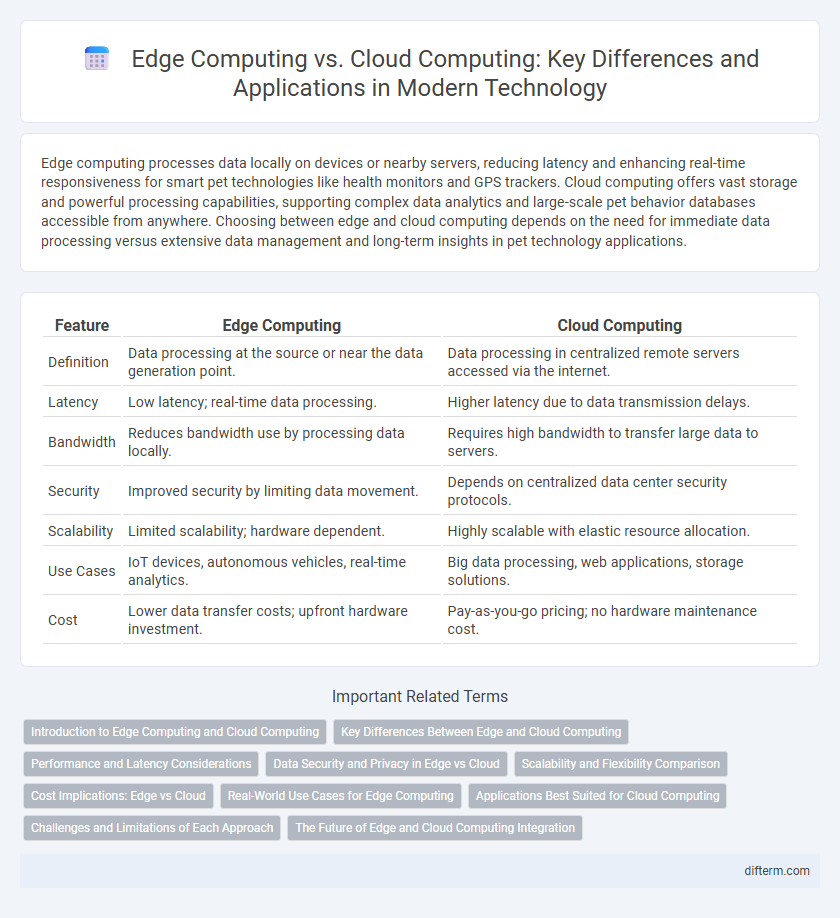Edge computing processes data locally on devices or nearby servers, reducing latency and enhancing real-time responsiveness for smart pet technologies like health monitors and GPS trackers. Cloud computing offers vast storage and powerful processing capabilities, supporting complex data analytics and large-scale pet behavior databases accessible from anywhere. Choosing between edge and cloud computing depends on the need for immediate data processing versus extensive data management and long-term insights in pet technology applications.
Table of Comparison
| Feature | Edge Computing | Cloud Computing |
|---|---|---|
| Definition | Data processing at the source or near the data generation point. | Data processing in centralized remote servers accessed via the internet. |
| Latency | Low latency; real-time data processing. | Higher latency due to data transmission delays. |
| Bandwidth | Reduces bandwidth use by processing data locally. | Requires high bandwidth to transfer large data to servers. |
| Security | Improved security by limiting data movement. | Depends on centralized data center security protocols. |
| Scalability | Limited scalability; hardware dependent. | Highly scalable with elastic resource allocation. |
| Use Cases | IoT devices, autonomous vehicles, real-time analytics. | Big data processing, web applications, storage solutions. |
| Cost | Lower data transfer costs; upfront hardware investment. | Pay-as-you-go pricing; no hardware maintenance cost. |
Introduction to Edge Computing and Cloud Computing
Edge computing processes data closer to the source or devices generating it, reducing latency and bandwidth use, which is crucial for real-time applications like autonomous vehicles and IoT devices. Cloud computing centralizes data processing and storage in large data centers, offering scalable resources and extensive computational power for tasks such as big data analytics and machine learning. Both paradigms serve different needs, with edge computing enhancing speed and efficiency at the network edge, while cloud computing provides robust, centralized infrastructure for complex, resource-intensive workloads.
Key Differences Between Edge and Cloud Computing
Edge computing processes data locally on devices or near the data source, reducing latency and enabling real-time analytics, while cloud computing relies on centralized data centers, offering scalable resources and extensive storage capabilities. Edge computing enhances security by limiting data transmission, whereas cloud computing provides broader integration with advanced AI and machine learning services. The primary trade-off involves balancing speed and immediacy at the edge against the high computational power and global accessibility of the cloud.
Performance and Latency Considerations
Edge computing significantly reduces latency by processing data closer to the source, which enhances real-time performance for applications like autonomous vehicles and IoT devices. Cloud computing offers high scalability and extensive computational power but often experiences increased latency due to data transmission to centralized data centers. Choosing between edge and cloud computing depends on the specific performance requirements and latency sensitivity of the application.
Data Security and Privacy in Edge vs Cloud
Edge computing enhances data security and privacy by processing information locally on devices, minimizing exposure to centralized cloud vulnerabilities and reducing latency risks. Cloud computing, while offering robust security protocols and compliance certifications, involves transmitting data to remote servers, increasing potential attack surfaces and privacy concerns. Choosing edge computing mitigates data breaches by limiting data transfer and enabling real-time encrypted processing closer to the data source.
Scalability and Flexibility Comparison
Edge computing offers enhanced scalability by processing data closer to the source, reducing latency and bandwidth usage, which enables real-time applications to scale efficiently. Cloud computing provides superior flexibility through virtually unlimited resources and centralized management, allowing seamless scaling of workloads across global data centers. Both paradigms cater to distinct scalability and flexibility needs, with edge excelling in localized processing and cloud dominating in resource availability.
Cost Implications: Edge vs Cloud
Edge computing reduces data transfer costs by processing information locally, minimizing bandwidth usage and latency expenses compared to centralized cloud services. Cloud computing often incurs higher operational costs due to data storage, continuous data transmission, and resource scaling in remote data centers. Businesses balancing initial infrastructure investments with ongoing maintenance typically find edge computing more cost-effective for latency-sensitive applications.
Real-World Use Cases for Edge Computing
Edge computing enhances real-time data processing by deploying computation near data sources, crucial for autonomous vehicles where instant decision-making is vital. It supports smart manufacturing by enabling predictive maintenance and minimizing downtime through local data analysis. In healthcare, edge computing facilitates remote patient monitoring with low latency, improving response times and patient outcomes.
Applications Best Suited for Cloud Computing
Cloud computing is ideal for large-scale data analytics, machine learning model training, and enterprise-level applications requiring extensive computational resources and centralized data management. Applications such as customer relationship management (CRM) systems, enterprise resource planning (ERP) software, and big data processing benefit from cloud environments due to their scalability, flexibility, and global accessibility. Cloud platforms like AWS, Microsoft Azure, and Google Cloud provide robust infrastructures supporting high availability, disaster recovery, and seamless integration with other cloud services.
Challenges and Limitations of Each Approach
Edge computing faces challenges such as limited processing power, storage capacity, and higher maintenance costs due to distributed infrastructure, which impacts scalability and consistent security enforcement. Cloud computing struggles with latency issues, data privacy concerns, and dependence on continuous internet connectivity, limiting real-time application performance and control over sensitive data. Both approaches require tailored strategies to balance resource allocation, data management, and security protocols to optimize technological deployment.
The Future of Edge and Cloud Computing Integration
Edge computing enhances real-time data processing by minimizing latency through localized servers, while cloud computing provides scalable storage and extensive processing power. The future of technology lies in seamless integration, leveraging the strengths of edge devices for instant analytics and cloud platforms for long-term data management. Businesses adopting hybrid architectures will benefit from improved efficiency, reduced bandwidth costs, and accelerated AI-driven decision-making capabilities.
Edge computing vs Cloud computing Infographic

 difterm.com
difterm.com